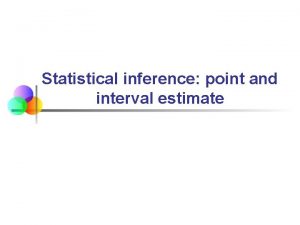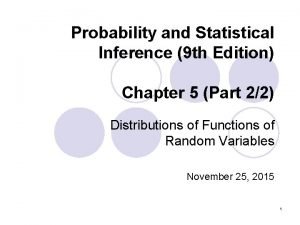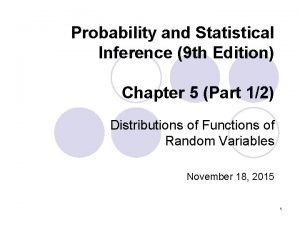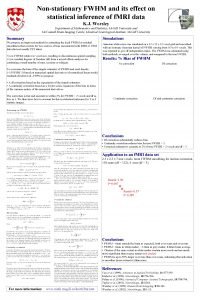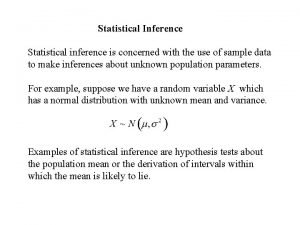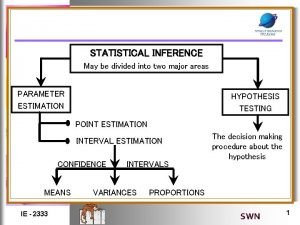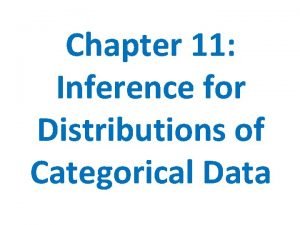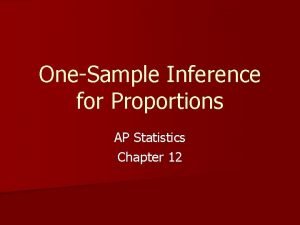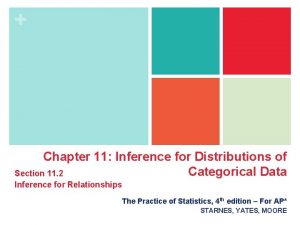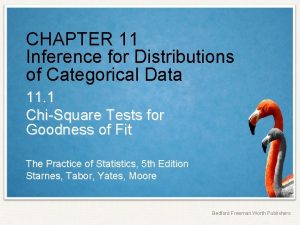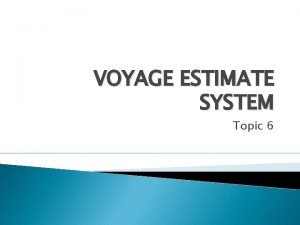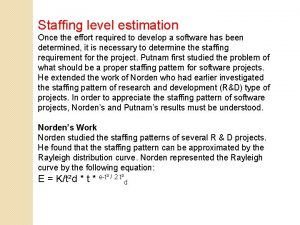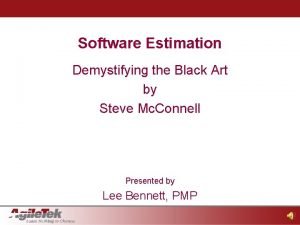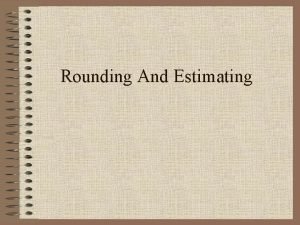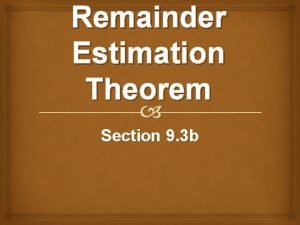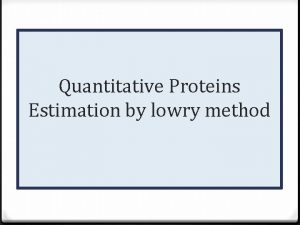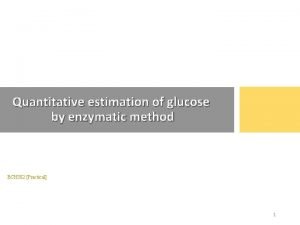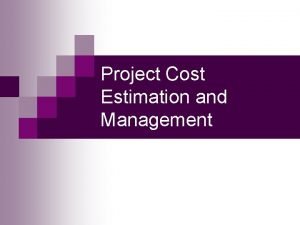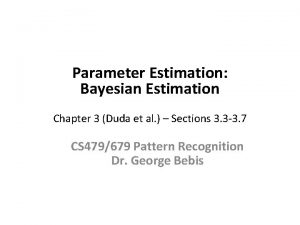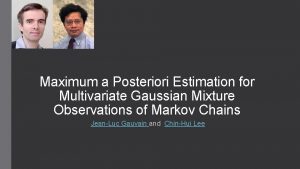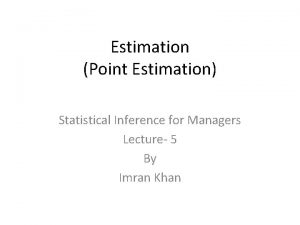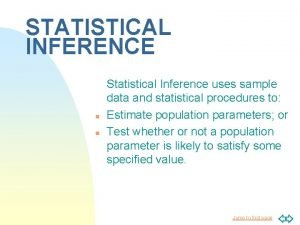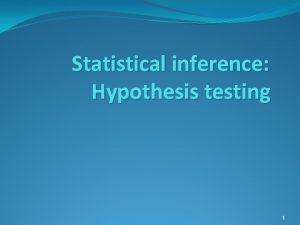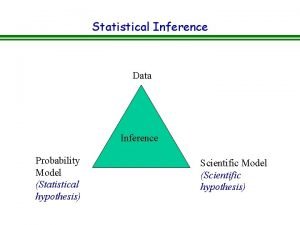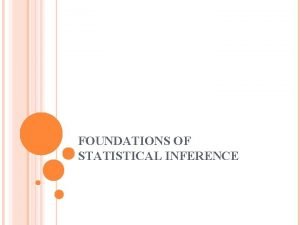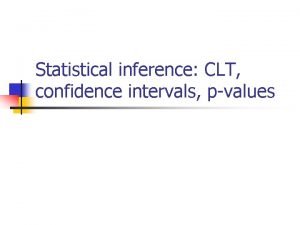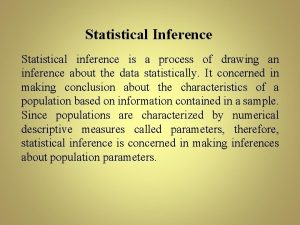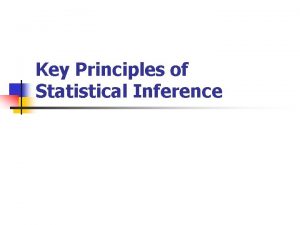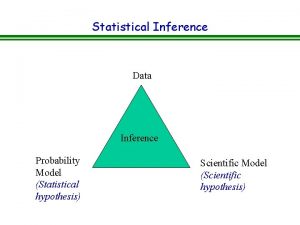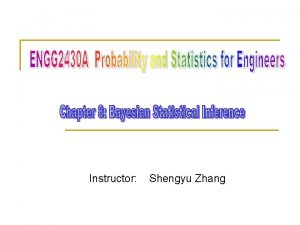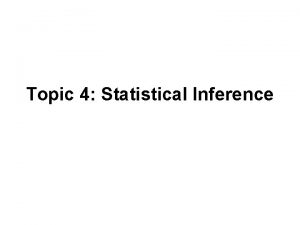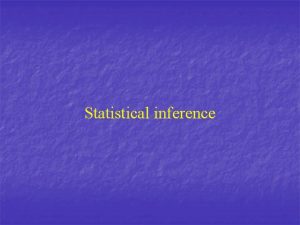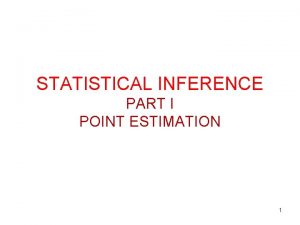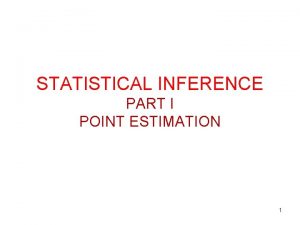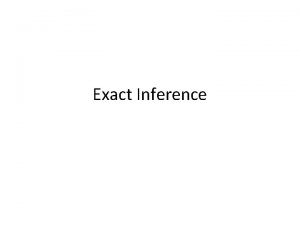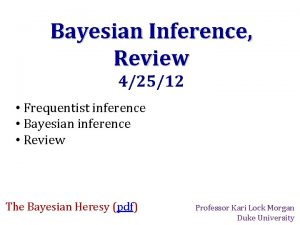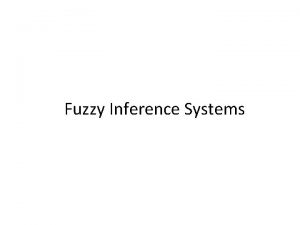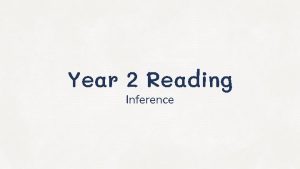CHAPTER 2 Statistical Inference 2 1 Estimation v























- Slides: 23

CHAPTER 2 Statistical Inference 2. 1 Estimation v Confidence Interval Estimation for Mean and Proportion v Determining Sample Size 2. 2 Hypothesis Testing: v Tests for one and two means v Test for one and two proportions

What is a Hypothesis? A hypothesis is a claim (assumption) about a population parameter: n Hypothesis testing can be used to determine whether a statement about the value of a population parameter should or should not be rejected. population mean Example: The mean monthly cell phone bill in this city is μ = RM 92 population proportion Example: The proportion of adults in this city with cell phones is p = 0. 68

Hypothesis Testing A statistical test of hypothesis consist of : 1. The Null hypothesis, 2. The Alternative hypothesis, 3. The test statistic 4. The rejection region 5. The conclusion A null hypothesis is a claim (or statement) about a population parameter that is assumed to be true. An alternative hypothesis is a statement that specifies that the population parameter has a value different in some way, from the value given in the null hypothesis. Test Statistic is a function of the sample data on which the decision (reject or do not reject) is to be based. Rejection region is a region for which the null hypothesis will be rejected.

The Hypothesis Testing Process Claim: The population mean age is 50. H 0: μ = 50, H 1: μ ≠ 50 Sample the population and find sample mean. Population Sample

Suppose the sample mean age was . This is significantly lower than the claimed mean population age of 50. If the null hypothesis were true, the probability of getting such a different sample mean would be very small, so you reject the null hypothesis. In other words, getting a sample mean of 20 is so unlikely if the population mean was 50, you conclude that the population mean must not be 50. (reject null hypothesis )

6 Steps in Hypothesis Testing 1. State the null hypothesis, H 0 and the alternative hypothesis, H 1 2. Choose the level of significance, and the sample size, n 3. Determine the appropriate test statistic 4. Determine the critical values that divide the rejection and non rejection regions 5. Collect data and compute the value of the test statistic 6. Make the statistical decision and state the managerial conclusion. If the test statistic falls into the non rejection region, do not reject the null hypothesis H 0. If the test statistic falls into the rejection region, reject the null hypothesis. Express the managerial conclusion in the context of the problem

Developing Null and Alternative Hypotheses Alternative Hypothesis as a Research Hypothesis Many applications of hypothesis testing involve an attempt to gather evidence in support of a research hypothesis. In such cases, it is often best to begin with the alternative hypothesis and make it the conclusion that the researcher hopes to support. The conclusion that the research hypothesis is true is made if the sample data provide sufficient evidence to show that the null hypothesis can be rejected.

How to decide whether to reject or accept ? The entire set of values that the test statistic may assume is divided into two regions. One set, consisting of values that support the and lead to reject , is called the rejection region. The other, consisting of values that support the is called the acceptance region. Tails of a Test Two-Tailed Test Sign in = Sign in Rejection Region In both tail Left-Tailed Test = or Right-Tailed Test < > In the left tail In the right tail = or

Hypothesis Test on the Population Mean, Test Statistic : • is known and n is large • is unknown and n is small

Example

Solution

Example The daily yield for a local chemical plant has averaged 880 ton for the last several years. The quality control manager would like to know whether this average has changed in recent months. She randomly selects 50 days from the computer database and computes the average and standard deviation of the n = 50 yields as = 871 tons and s = 21 tons, respectively. Test the appropriate hypothesis using α=0. 05. Solution

Hypothesis Test For the Difference between Two Populations Means, Test statistics: • • •

• • Alternative hypothesis Rejection Region

Example

Solution

Hypothesis Test on the Population Proportion, p Alternative hypothesis Rejection Region

Example When working properly, a machine that is used to make chips for calculators does not produce more than 4% defective chips. Whenever the machine produces more than 4% defective chips it needs an adjustment. To check if the machine is working properly, the quality control department at the company often takes sample of chips and inspects them to determine if the chips are good or defective. One such random sample of 200 chips taken recently from the production line contained 14 defective chips. Test at the 5% significance level whether or not the machine needs an adjustment.

Solution

Hypothesis Test For the Difference between Two Population Proportion, Alternative hypothesis Rejection Region

Example A researcher want to estimate the difference between the percentages of users of two toothpastes who will never switch to another toothpaste. In a sample of 500 users of Toothpaste A taken by a researcher, 100 said that the will never switch to another toothpaste. In another sample of 400 users of Toothpaste B taken by the same researcher, 68 said that they will never switch to another toothpaste. At the significance level 1%, can we conclude that the proportion of users of Toothpaste A who will never switch to another toothpaste is higher than the proportion of users of Toothpaste B who will never switch to another toothpaste?

Solution

End of Chapter 2
 What is a point estimate in statistics
What is a point estimate in statistics Chebyshev inequality proof
Chebyshev inequality proof Probability and statistical inference 9th solution pdf
Probability and statistical inference 9th solution pdf Statistical inference
Statistical inference Statistical inference is concerned with
Statistical inference is concerned with Statistical inference is divided into
Statistical inference is divided into Biologists wish to cross pairs of tobacco plants
Biologists wish to cross pairs of tobacco plants Chapter 12 inference for proportions answers
Chapter 12 inference for proportions answers Chapter 11 inference for distributions of categorical data
Chapter 11 inference for distributions of categorical data Chapter 11 inference for distributions of categorical data
Chapter 11 inference for distributions of categorical data Dataloy voyage management system
Dataloy voyage management system God and pod method
God and pod method Factors affecting sanitary sewage
Factors affecting sanitary sewage Estimation clipboards
Estimation clipboards Post estimation test
Post estimation test Staffing level estimation
Staffing level estimation Software estimation: demystifying the black art
Software estimation: demystifying the black art Front end estimation decimals
Front end estimation decimals Remainder estimation theorem
Remainder estimation theorem Protein estimation by lowry method
Protein estimation by lowry method Enzymatic method of blood glucose estimation
Enzymatic method of blood glucose estimation Objectives of cost estimation
Objectives of cost estimation Bayesian estimation
Bayesian estimation Maximum a posteriori estimation for multivariate gaussian
Maximum a posteriori estimation for multivariate gaussian
